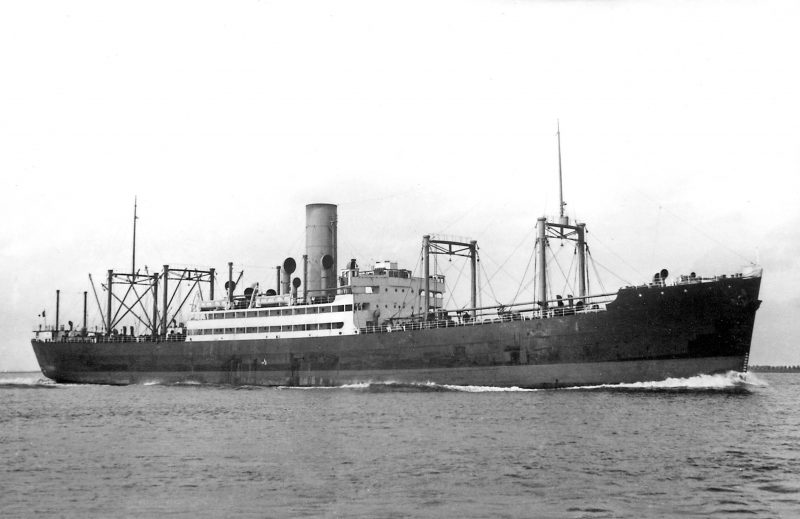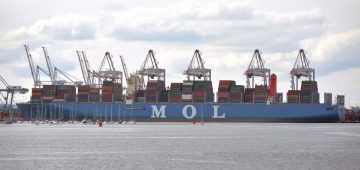
The winner of the November competition was Alan Frost of Sunderland
AD Frost writes:
This months ‘Unknown Ship’ is one of 5 sister ships of Canadian Pacific’s ‘Beaver’ class” built at various yards between 1927-29. SS Beaverbrae, built 1927 Armstrong, Whitworth & Co. Ltd., Low Walker, Tyne. Sank on 25.03.1941 after being bombed in the North Atlantic on a voyage from Liverpool to Saint John, NB with general cargo.

Eric McIntyre writes:
The ship could be the Canadian Pacific steamer Beaverford, built in Glasgow in 1928 by Barclay Curle & Co., Whiteinch. She was 10,042grt and 503′ long with 2 three stage parsons turbines 8,000 who. She was launched in October 1927 and her maiden voyage was on 21.01.1928. In October 1940 she was in convoy HX 84 and was sighted by aircraft from the German cruiser Admiral Sheer on the 5.11.1940. The convoy’s only escort was HMS Jervis Bay who signalled the convoy to scatter. Jervis Bay was sunk within an hour. The Beaverford then turned to fight the raider armed with only one 4″ gun and one 3″gun and fought for four or five hours before she was torpedoed by the raider. As the Beaverford was carrying ammunition in the forward hold she blew up and sank taking all her crew with her. Those actions helped the convoy escape including the San Demetrio. Beaverford was one of five sisters, Beaverburn, Beaverdale, Beaverhill & Beaverbrae were the others.

Alan Blackwood writes:
This month’s ‘unknown’ is the 9,956 grt twin screw part refrigerated turbine steamer Beaverbrae, the last example of five fundamentally outwardly identical ice strengthened hulled sisters, ordered during June 1926 by the Canadian Pacific Steamship Company, London, for Surrey Commercial Docks based weekly departures on North Atlantic all-cargo liner operations. With regular en route calls at Hamburg and Antwerp with an additional call at Le Havre between 1928 and 1932, each sister was required to undertake six round voyages per ‘summer’ season to Montreal and four round voyages to Saint John (New Brunswick) during winter operations. Upon delivery, the sisters were registered to the ownership of the Canadian Pacific Railway Company, with PoR as London and the Canadian Pacific S.S. Co. as managers. Whilst the design of the quintet including essentially common technical specifications throughout, was undertaken by William Denny Brothers of Dumbarton, as an expedient to ensure early delivery, Dennys themselves were awarded construction of the prototype example only, Barclay Curle & Co., of Whiteinch contracted for two units and Armstrong-Whitworth (Sir William G. Armstrong & Co.) also for two at their High Walker yard, including the subject Beaverbrae, completed during early March 1928. Dimensions of the vessel were 520′ (loa) x 502’7.5″(lbp) x 62′ (max. beam) x 37’7″ moulded depth. Boiler installation included two single ended Scotch boilers for port services related use and four water tube boilers for propulsion, supplying 250 (C) super heated steam at 252 psi via six furnaces to feed two sets of three stage Parsons type steam turbines producing 8,000 shp., single reduction geared to twin screws to return a specification service speed in all weathers of 14.5 knots, but with significant power in reserve to maintain service schedules when required. With a bunker capacity of approximately 2,500 tons, the Clydebuilt sisters were equipped with Erith-Roe automatic stoker systems. Strangely the Tyneside built pair were not, relying instead upon traditional hand fuel feed. On arrival at London on 3rd September 1939 – the day upon which war was declared with Germany, Beaverbrae was requisitioned initially by the British Government for cargo only operations, sailing six days later for Canada and from 1st March 1940 requisitioned by the Admiralty for carriage of war materiel. During 25th March 1941, when just less than two days into an outbound voyage from Liverpool and in a position some 100 nautical miles SW of the Faroes, she was bombed by a German Focke-Wulf aircraft, suffered two crew casualties, whilst sustaining severe damage to her afterdeck, blowing hatches open, destroying her upper cargo decks and causing fractures to her boiler systems, a collapsed engineroom watertight bulkhead and a major conflagration below. Some 35 minutes later it became evident that crew fire fighting efforts were to no avail and the decision made to abandon ship. The Master however remained on board for a further one hour and forty minutes to ensure that all surviving crew were safely evacuated before jumping overboard himself to be picked up by a waiting lifeboat. Over the ensuing hours a number of RAF patrol aircraft dropped a series of supplies to the boats before, some 7 hours later, all crew were taken aboard two RN destroyers for transfer to Scapa Flow and onwards via Scrabster to Thurso for train travel south. Beaverbrae was the third of four of the sisters to be sunk through WWII enemy action, with the loss of the sole remaining unit by stranding on a reef at Halifax NS. during late November 1943, caused when a towing hawser parted and was wound around a propeller amidst adverse wind and tide conditions.

Peter Sommerville writes:
This ship is one of five built for Canadian Pacific during 1927/28. They were large cargo carriers with accommodation for twelve passengers and designed to operate between London and Montreal during summer months and Nova Scotia in the winter. The ships in question were the Beaverbrae, Beaverburn, Beaverhill, Beaverdale and Beaverford but were all lost between 1940 and 1944 due to enemy action or stranding. I will go for the Beaverford (10,042gt) built by Barclay Curle Glasgow who met her end on the 5th November 1940 after coming under attack from the German pocket battleship Admiral Scheer (reclassified as heavy cruiser) while trying to protect the Jervis Bay.

John Manson writes:
This month’s unknown ship is the Beaverburn, built by William Denny in 1927 for the Canadian Pacific Railwayy. She was a steam driven vessel, twin screws giving her a speed of 14 knots.She served on the London Royal Docks and Continental ports run to the St. Lawrence river ports in the summer, diverting to the winter ports of Nova Scotia and New Brunswick. Sge continued on that service until sunk by a U Boat during convoy duties. Her three sisterships Beaverdale, Beaverbrae and Beaverford were also sunk by U Boats and the Admiral Scheer.

Peter Harris writes:
The vessel pictured is one of five sister ships built for the Canadian Pacific North Atlantic run in 1927/28. Twin screws and 10,000 tons. Shipyards were Barclay Curle, Armstrong Whitworth and Denny’s. None survived the war. Beaverdale U48, Beaverburn U41, Beaverford Admiral Scheer, Beaverhill Stranded, Beaverbrae aircraft bombing. As they were all sister ships I would have to make a guess and say Beaverdale.

CT Baxter writes:
I believe the ship is one of 5 sisterships built as follows for Canadian Pacific Steamships of London. 1. Beverbrae, built by Armstrong Whitworth in 1928. 2. Beaverburn, built by Denny in 1927. 3. Beaverdale, built by Armstrong Whitworth in 1928. 4. Beaverford, built by Barclay, Curle in 1928. 5. Beaverhill, built by Barclay, Curle in 1928. Four were lost in the war as follows:-
Beaverbrae – 25.3.41 bombed and sunk by Kondor aircraft. Beaverburn – 5.2.40 torpedoed by U41 in convoy OB84. Beaverdale – 2.4.41 torpedoed by U48 in convoy SC26. Beaverford – 5.11.40 shelled and sunk in convoy HX84 by Admiral Scheer.

Doug Burn writes:
I think the November mystery ship is Beaverburn, 9,874 tons, 503 feet in length. Built at William Denny + Brothers Ltd. She was launched and sailed Christmas Eve 1927. If this is the right ship though searching was hard she was one of 5 in the class, they were Beaverburn, Beaverford, Beaverdale, Beaverhill and Beaverbrae. All in service 1928-1929. Problem is which one is it? If it is the “Burn” she was sunk by U-41 in convoy OA-84. All four ships except Beaverhill were sunk in WW2, but the “Hill” ran aground in 1944.

John Jordan writes:
This ship is one 5 sisters built for Canadian Pacific in 1927 /1928. They were 10,000 tonners, steam turbine with a service speed of 15.5 knots. They had a distinctive goalpost arrangements of four twin masts. They were Beaverford and Beaverhill built by Barclay Curle, and Beaverbrae and Beaverdale built by Armstrong Whitworth, and Beaverburn built by Dennys. They all came to a sticky end. I am going to select Beaverford as my ship selection as she died as a fighting ship, stepping into the breach when Jervis Bay was sunk trying to deter Admiral Scheer from continuing to decimate Convoy HX 84. None of her crew of 77 survived. All ships were lost during WWII by enemy action except Beaverhill who went up on a reef in St. John’s New Brunswick, Canada in November 1944 and became a total loss.after a salvage attempt.

Gerald Dodd writes:
I believe that the unknown ship of the month for November is the Beaverford. Built in 1928 for the the Canadian Pacific Railway Co Ltd, but operated by the Canadian Pacific Steamship Co, at Barclay Curle and Co Ltd, Glagow. She was built for their freight service between Montreal and London. The Beaverford was requistioned to carry war supplies and she was sunk on November 5th 1940 in Convoy HX84 by the pocket battleship Admiral Scheer. The Beaverford engaged with the pocket battleship in an attempt to allow the remainder of the convoy to escape. Captain Pettigrew made the decision to turn his vessl around and face the German pocket battleship. After receiving many shell hits she was finally sunk by torpedoes fired by the pocket battleship. All 73 members of the crew, including the master, Capt Pettigrew, were lost in the action on November 5th 1940.







Comments
Sorry, comments are closed for this item